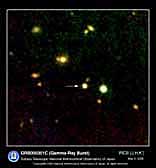Press Release
Subaru Catches a Burst from Space
May 4, 2000
 Image (JPEG 129KB) Caption (TEXT) |
Object Name: Gamma-Ray Burst GRB000301C Telescope: Subaru Telescope / Cassegrain Focus Instrument: IRCS Filter: J(1.25micron), H(1.65micron), K'(2.12micron) Color: Blue (J), Green (H), Red (K') Date: UT2000 March 3 Exposure: JHK' 18min each Field of View: about 1.5 arcmins Orientation: North to the top, East to the left Position: RA(J2000.0)=16h20m18.6s, Dec(J2000.0)=+29d26m36s (Corona Borealis) |
Explanation:
The Subaru Telescope with IRCS
attached to the
Cassegrain focus made observations of the optical
transient (OT) of Gamma-Ray Burst GRB000301C. Gamma-Ray
Bursts (GRBs for short) are a phenomenon in which a huge
amount of energy is released as gamma ray (wavelength
< 0.1 nanometer) in a matter of seconds. GRBs were
first discovered about 30 years ago but their physical
nature has not yet been determined.
Subaru's prompt follow-up provided the first precise near-infrared photometric data for this object. Our results were reported as the GRB Coordinates Network (Note) Circular GCNC 577, 587 (http://gcn.gsfc.nasa.gov/gcn/gcn3_archive.html) and have been cited by a number of scientific papers being submitted. Astronomers believe that by studying the way in which the optical transients of GRBs fade it will be possible to better understand them.
(Note) :The GRB Coordinates Network: please refer to http://gcn.gsfc.nasa.gov/gcn/gcn_main.html.